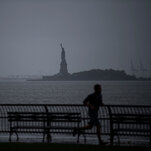
Tropical Storm Henri Brings Power Outages and Record Rain to Northeast

The storm was expected to continue dumping rain across the region through Monday night, prompting flood watches in several states.



Tropical Storm Henri battered the Northeast with fierce winds and torrential rain on Sunday, knocking out power in most of coastal Rhode Island, forcing evacuations in Connecticut, stranding dozens of motorists in New Jersey and shattering rainfall records in New York City.
But the storm, which was downgraded from a hurricane hours before making landfall in Rhode Island, spared the region the worst of what had been predicted, and it weakened quickly as it made its way north. At its peak on Sunday afternoon, the storm left more than 140,000 households without power from New Jersey to Maine.
The storm — the second tropical storm to hit the Northeast this season, after Elsa last month — prompted Providence, R.I., and New Bedford, Mass., to close the hurricane barriers in their ports, the first time they had done so for a storm since Sandy in 2012.
It was expected to continue dumping rain across the region through Monday night — up to another three inches, said Dominic Ramunni, a National Weather Service meteorologist on Long Island. Flood watches were in effect through Monday night in parts of New York, New Jersey, Connecticut, Rhode Island, Massachusetts, Vermont and New Hampshire. By Sunday night, it had been downgraded to a tropical depression.
Rains heralding the storm’s arrival reached New York City on Saturday evening, cutting short a heavily promoted concert in Central Park just as Barry Manilow was about to perform “Can’t Smile Without You.”
From 10 p.m. to 11 p.m., 1.94 inches of rain fell on Central Park, the most ever recorded in the city in a single hour, the Weather Service said. The 4.45-inch total for the day set a record for Aug. 21, and the total of 7.04 inches that had fallen by Sunday evening made for the biggest two-day rainfall since Hurricane Irene in 2011, Mr. Ramunni said.
In Newark, emergency medical workers rescued more than 80 people stranded in cars on flooded streets, including 16 children, city officials said. Widespread road flooding was reported across New Jersey and New York City.
Image
Farther north and east, on Long Island and across coastal New England, residents, businesses and officials prepared themselves as the storm bore down Sunday morning.
Most of downtown Montauk, N.Y., at Long Island’s eastern tip, was shut down, save for a pancake house and a 7-Eleven with its windows boarded up and “open” spray-painted in neon orange.
To the west, in Long Beach, a few brave or foolhardy surfers rode towering waves. At Jones Beach nearby, Andy Lawrence, 76, and his 8-year-old granddaughter, Harper, were among the few human dots on the landscape. “We’re a family of storm-chasers,” Mr. Lawrence said.
Harper added, “I like how strong the wind is — it feels weird on my rain jacket.”
The storm gave New York’s outgoing governor, Andrew M. Cuomo, a final opportunity to prove his emergency-management mettle.
Mr. Cuomo, who received national attention for his leadership during the coronavirus pandemic, declared a state of emergency so New York could use federal funds to prepare for floods and other possible effects of the storm — though he acknowledged that officials did not expect “any real significant damage post the event.” Mr. Cuomo has announced he would step down on Monday night in the wake of a sexual harassment scandal. States of emergency were also declared in Rhode Island and Connecticut.
As the rains fell, the Metro-North Railroad and Long Island Rail Road canceled much of their service in New York and Connecticut, hundreds of flights were canceled at airports in the New York metropolitan area, and parts of New York City’s subway system briefly stopped service.
Officials in Connecticut issued evacuation orders in coastal parts of several towns, including East Haven, Madison, Groton and Branford. About 250 residents of four nursing homes — in Old Saybrook, Mystic, Guilford and West Haven — were evacuated, state officials said.
Rhode Island officials closed three bridges because of high winds, and the state banned motorcycles and tractor-trailers.
Against gathering winds, the 400-ton steel doors of the hurricane barrier in New Bedford, Mass., groaned into place, sealing off the region’s largest fishing port. The vessels that made it inside were packed tight — wooden sailboats and lavish yachts jammed beside the rusted fishing boats more typical of the industrial harbor. Those still at sea were expected to find another port.
Off Block Island, south of mainland Rhode Island, a 19-foot wave was recorded around 9 a.m. At 11 a.m., the heart of the storm passed over Block Island, and at 12:15 p.m., Henri made landfall in Westerly, R.I., with sustained winds of 57 miles per hour in nearby Port Judith and a gust of 70 m.p.h.
By then, the winds and rain had downed trees and power lines across the state, and 80,000 homes in Rhode Island were without power, according to the utility National Grid. About three-quarters of households went dark in Washington County, R.I., which is home to more than 125,000 people and includes Westerly.
Over the course of the afternoon, crews worked frantically to get the lights back on, but as of 10 p.m. Sunday, more than 50,000 Rhode Island homes were still without power.
As the afternoon wore on, the storm tracked a northwest course across Connecticut, headed toward Western Massachusetts, and was expected to cut east along southern Vermont, New Hampshire and Maine before heading out to sea again.
In New London on Connecticut’s southeast coast, a storm shelter with room for 200 people admitted just two on Sunday morning. By afternoon, the sun had broken through the clouds.
On the Massachusetts coast, the approaching storm had churned up memories of Hurricane Bob, which killed more than a dozen people, caused $680 million in damage and altered the Cape Cod coastline in 1991.
Sunday’s forecast for Martha’s Vineyard, an island just south of Cape Cod, “looked like we were dead in the cross hairs” of a hurricane, said Charlie Blair, harbormaster in the town of Edgartown.
But the storm ended up with manageable winds of about 30 m.p.h., and patrol boats were back in the water by noon, Mr. Blair said.
“Bob blew 111 here,” he said, meaning 111 m.p.h. “There’s a huge difference between 30 and 111. It was whiteout conditions, just screaming. We didn’t have any of that today. We’re really lucky.”
Andy Newman reported from New York and Ellen Barry from Boston. Reporting was contributed by Colleen Cronin from Providence, R.I.; Kristin Hussey from Stratford, Conn.; Daniel Jackson from New London, Conn.; Sarah Maslin Nir from East Hampton, N.Y.; Christine Sampson from Montauk, N.Y.; Nate Schweber from Jones Beach, N.Y.; and Will Sennott from New Bedford, Mass. Reporting was also contributed by Melissa Guerrero, William Lamb, Eduardo Medina, Dana Rubinstein and Mihir Zaveri.
Source: https://www.nytimes.com/2021/08/22/nyregion/tropical-storm-henri.html

















